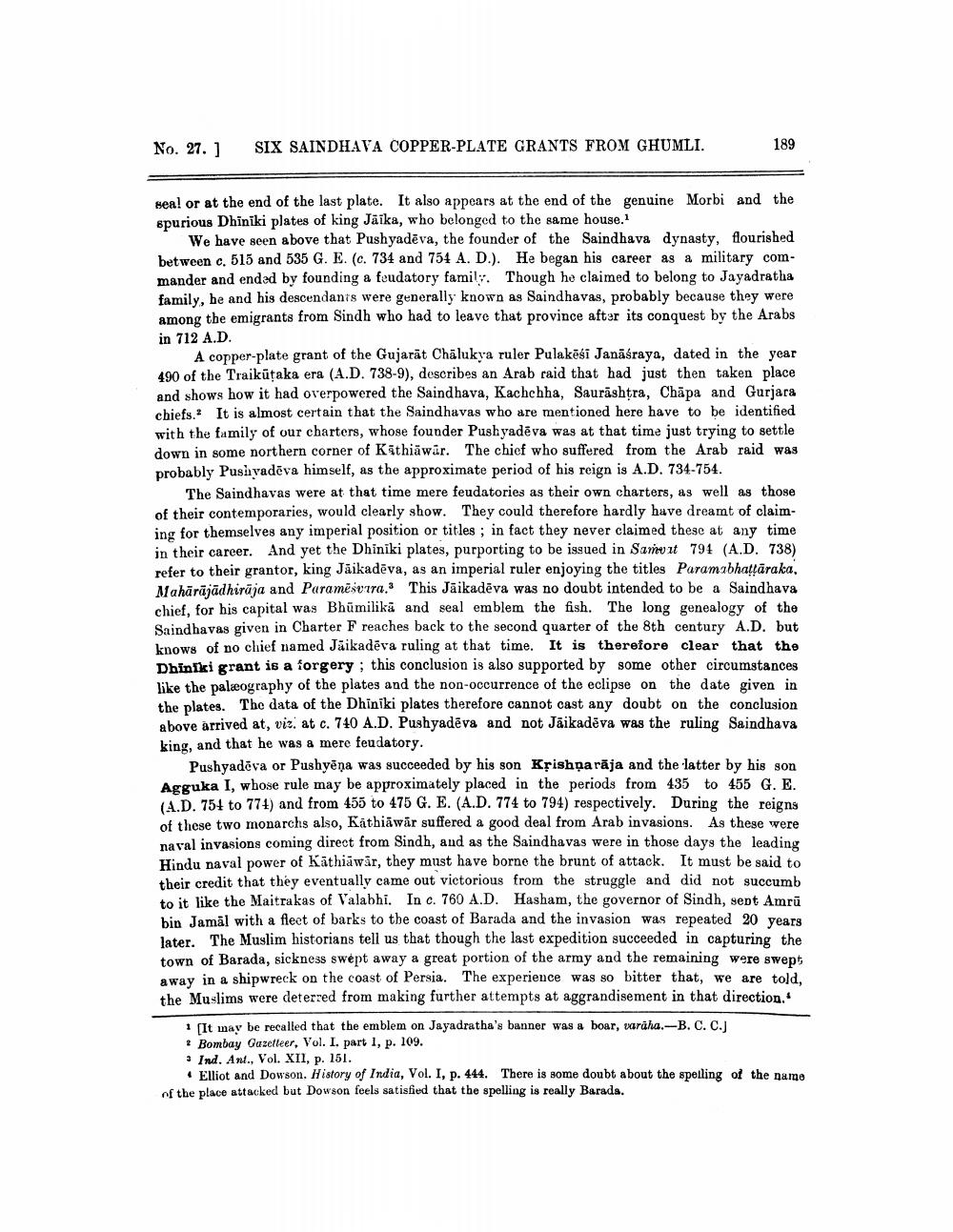________________
No. 27. ]
SIX SAINDHAVA COPPER-PLATE GRANTS FROM GHUMLI.
189
seal or at the end of the last plate. It also appears at the end of the genuine Morbi and the spurious Dhiniki plates of king Jaika, who belonged to the same house.1
We have seen above that Pushyadeva, the founder of the Saindhava dynasty, flourished between c. 515 and 535 G. E. (c. 734 and 754 A. D.). He began his career as a military commander and ended by founding a feudatory family. Though he claimed to belong to Jayadratha family, he and his descendants were generally known as Saindhavas, probably because they were among the emigrants from Sindh who had to leave that province after its conquest by the Arabs in 712 A.D.
A copper-plate grant of the Gujarat Chalukya ruler Pulakesi Janasraya, dated in the year 490 of the Traikuṭaka era (A.D. 738-9), describes an Arab raid that had just then taken place and shows how it had overpowered the Saindhava, Kachchha, Saurashtra, Chapa and Gurjara chiefs. It is almost certain that the Saindhavas who are mentioned here have to be identified with the family of our charters, whose founder Pushyadeva was at that time just trying to settle down in some northern corner of Kathiawar. The chief who suffered from the Arab raid was probably Pushyadeva himself, as the approximate period of his reign is A.D. 734-754.
The Saindhavas were at that time mere feudatories as their own charters, as well as those of their contemporaries, would clearly show. They could therefore hardly have dreamt of claiming for themselves any imperial position or titles; in fact they never claimed these at any time in their career. And yet the Dhiniki plates, purporting to be issued in Samvat 794 (A.D. 738) refer to their grantor, king Jāikadēva, as an imperial ruler enjoying the titles Paramabhaṭṭāraka, Mahārājādhiraja and Paramesvara. This Jaikadeva was no doubt intended to be a Saindhava chief, for his capital was Bhumilika and seal emblem the fish. The long genealogy of the Saindhavas given in Charter F reaches back to the second quarter of the 8th century A.D. but knows of no chief named Jaikadeva ruling at that time. It is therefore clear that the Dhiniki grant is a forgery; this conclusion is also supported by some other circumstances like the palæography of the plates and the non-occurrence of the eclipse on the date given in the plates. The data of the Dhiniki plates therefore cannot cast any doubt on the conclusion above arrived at, viz. at c. 740 A.D. Pushyadeva and not Jaikadeva was the ruling Saindhava king, and that he was a mere feudatory.
Pushyadeva or Pushyēņa was succeeded by his son Krishṇarāja and the latter by his son Agguka I, whose rule may be approximately placed in the periods from 435 to 455 G. E. (A.D. 754 to 774) and from 455 to 475 G. E. (A.D. 774 to 794) respectively. During the reigns of these two monarchs also, Kathiawar suffered a good deal from Arab invasions. As these were naval invasions coming direct from Sindh, and as the Saindhavas were in those days the leading Hindu naval power of Kathiawar, they must have borne the brunt of attack. It must be said to their credit that they eventually came out victorious from the struggle and did not succumb to it like the Maitrakas of Valabhi. In c. 760 A.D. Hasham, the governor of Sindh, sent Amru bin Jamal with a fleet of barks to the coast of Barada and the invasion was repeated 20 years later. The Muslim historians tell us that though the last expedition succeeded in capturing the town of Barada, sickness swept away a great portion of the army and the remaining were swept, away in a shipwreck on the coast of Persia. The experience was so bitter that, we are told, the Muslims were deterred from making further attempts at aggrandisement in that direction.
1 [It may be recalled that the emblem on Jayadratha's banner was a boar, varaha.-B. C. C.J
2 Bombay Gazetteer, Vol. I. part 1, p. 109.
Ind. Ant., Vol. XII, p. 151.
Elliot and Dowson. History of India, Vol. I, p. 444. There is some doubt about the spelling of the name of the place attacked but Dowson feels satisfied that the spelling is really Barada.




